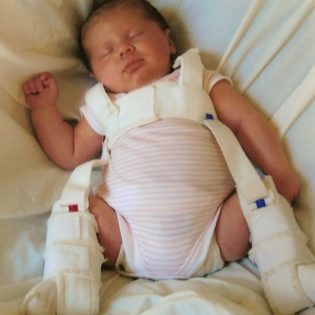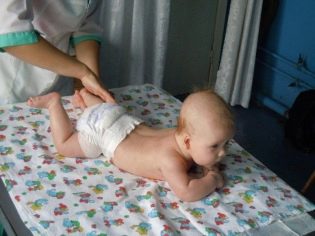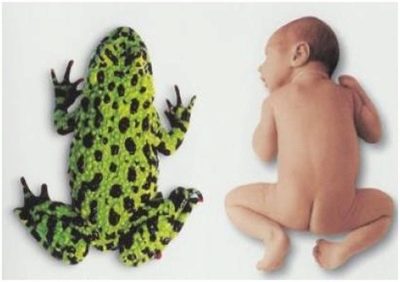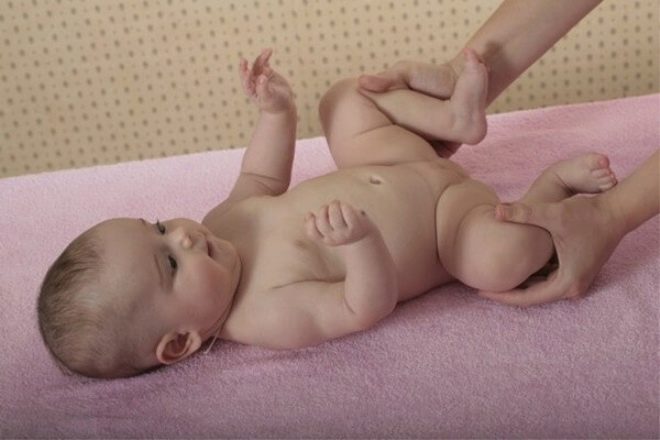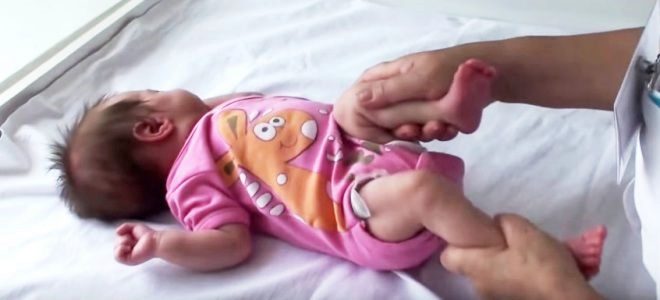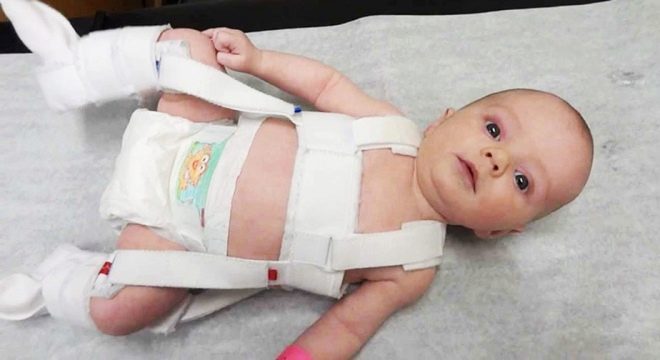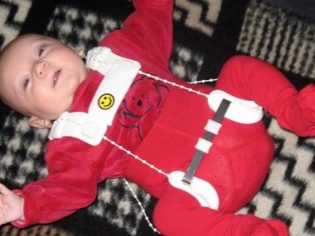Exercises for dysplasia of the hip joints in newborns and infants
Hip dysplasia can have a variety of causes. But most often the root of the problem lies in the immaturity of the bone and cartilage tissue in newborns and babies in the first months of life.
If such a problem is detected in a baby, parents are recommended to have wide swaddling, as well as special massage and therapeutic exercises. About what exercises will help with dysplasia in infants, you will learn from this article.
The role of gymnastics
Much in the choice of treatment depends on how big the problem is, what degree the dysplasia has, what is the angle of deviation from the norm. Some forms of the disease require surgery. But most often, doctors manage to detect dysplasia early, and therefore conservative therapy is prescribed.
Its basis is to find the toddler in the correct position with divorced legs and gymnastics. The exercises, which are described in classical systems and complex physical therapy, are not difficult, they can be mastered by any parent, but it is difficult for them to come up with a worthy alternative.
It should be noted that gymnastic exercises alone will not do much for the health of the child. In case of hip dysplasia, they must be combined with massage.
The exact set of exercises prescribed by the doctor, based on the degree of dysplasia and the age of the patient. Since gymnastics and massage are therapeutic, parents will have to take a few lessons from a professional masseuse and an exercise therapy specialist.
They will show the exercises and manipulations and tell you how many times they should be performed for a particular child, taking into account his individual pathology.
Effective complex
Since you should start with a massage, briefly tell you about the technique of its implementation. Parents should know that any massage to a child with dysplasia is performed only with stroking and light rubbing movements. There should be no deep kneading of the muscles.
If, on the recommendation of the orthopedic doctor, special orthopedic constructions - “spacers” - have been installed, it is not necessary to remove them in order to carry out the massage. The main thing - to do everything gently and very carefully.
Spend massaging only when the baby slept, not naughty, when he has the appropriate attitude to the game and communication. Any physical impact of a violent plan will cause a backlash, and classes will not benefit.
Put the child on the stomach on a hard surface so that his body does not “fall through,” start by rubbing and stroking the feet. Easily move them to the sides, go to the lower leg and the back of the thigh. After you massage the legs, go to the buttocks, back.
Pay attention to the area of the sacrum, it needs a longer massaging without pressure and strong pressure. After this, you can proceed to massaging the hip joint directly.
Put the child on the back, gently stroke the joint area with an open palm in a circular and arcuate movements. When the skin becomes warm, you can begin to perform the gymnastic complex.
We give the most common exercises that are prescribed for children with dysplasia. Consider that your child may need personal exercises, which the physician will definitely inform you about.
- "Princess Frog". This exercise helps to expand the range of motion of the hip joints. Place the baby on your stomach. Take the baby by the feet and lightly push them down so that their legs, when bred, are bent at the knees. The pose of the baby in this case will really resemble a frog pose. Hold for a few seconds and move the legs to the starting position. Do this 7 times. If the movement of the joint is severely restricted, do not try to achieve the impossible from the child - let the legs move only as long as the movement is free. Make sure the child does not hurt.
- "Steps". This exercise allows you to give the joint vertical mobility, strengthens the articular bag with a vertical load. The little dog lies on its back. Alternately bend the legs of the baby with both hands at the knee and hip joints. It will be similar to the sequence of movements when climbing the stairs. Reception do 7 times.
- "Sun". Position the toddler on his back, straighten his legs and gently spread them to the sides in a straight position. Make sure the baby does not bend them at the knees. You should not breed your limbs too wide, do not try to "put" the crumbs on the splits. It is enough if we can move the legs away from the central axis at an angle of 45 degrees.
- "Merry Frog". Put the baby on your back, bend his legs at the knees and hip joints, move your legs to the tummy and start to separate them to the sides in the bent state. If movement is limited, do not overdo it, so as not to injure the joints. Repeat the exercise 7-8 times.
- "Book". When performing this exercise, the legs of the baby, lying on his back, bend at the knees and spread to the sides. Outwardly, it resembles an opening book. You need to open and close the "book" at least 5-7 times.
- "Tadpole". At this reception, the hands of adults fix the lower limbs of the child so that the legs do not bend at the knees and remain straight. Better to make a grip on the shin. Straight legs in the supine position are raised to the head. The higher the better. In this case, the limbs are bent only in the hip joints. Raised legs are held for a few seconds, and then smoothly descend to the starting position. It is desirable to repeat the exercise 4-5 times.
- "Mill". This is an exercise to rotate the joint. The starting position for the child is supine. Hold the hips of the baby with your hands and start flowing movements around them. Try not to push progressively forward, so as not to injure the head of the thigh. You should not be surprised if you can’t describe normal circles from the first and even from the second time - the joint limits movement.
Take care that the child does not hurt, do not try to overcome physical resistance.
- "Bicycle". This exercise is known to everyone. Outwardly, it resembles the movement of the legs when the pedals of the corresponding two-wheeled vehicle are rotating. Bend the legs at the knees and make them rotational motion up and down.
- "Ladushki on the contrary." A very simple and fun exercise that kids usually like very much. Play palms, but not with your palms, but with your feet in the supine position. Do this under the appropriate rhyme at least 15-20 times.
- "Butterfly". Put the baby on your back. Bend the legs at the knees and “pat” them like butterfly wings, so that the bent knees meet and divorce synchronously. In 2.5-4 months, it is possible to start exercising with a child on fitball, if the attending physician does not object to the addition of elements of dynamic gymnastics.
Tips and tricks
It is important to know the following.
- Massage and gymnastics will bring the desired result much faster if parents remember the principle of position therapy. The kid should spend most of the time with divorced legs. With a mild degree of dysplasia, you can use a larger diaper, wide swaddling.In case of serious illness, bandaging is performed or special orthopedic appliances are recommended. No matter how sorry the baby is, do not give vent to your feelings and do not remove these devices.
- When performing gymnastics, if a child was bandaged or prescribed orthopedic “struts”, remember that not all of the above exercises can be performed. If you see that the movement of an exercise shifts the bandaging, do not perform it.
- Never insist on the continuation of gymnastics, if the child suddenly began to be naughty and nervous. Stop, rest, return to class later.
- The load should be increased gradually, introduce new exercises and complicate them. Start from 2-3 minutes per session and gradually bring the duration of the massage to 7-10 minutes, and the duration of the gymnastics - up to 10-15 minutes. The most effective course treatment will be - 15 days are carried out comprehensive exercises 2-3 times a day, then a two-week break is taken. The doctor may prescribe another course in which a break can be up to a month. During the period of rest, a child can be prescribed physiotherapy procedures.
- For the prevention of muscle disorders in a growing child with diagnosed TBS dysplasia, a daily relaxing massage is recommended before evening bathing.
Some exercises for hip dysplasia are described and shown by the doctor in the following video.




